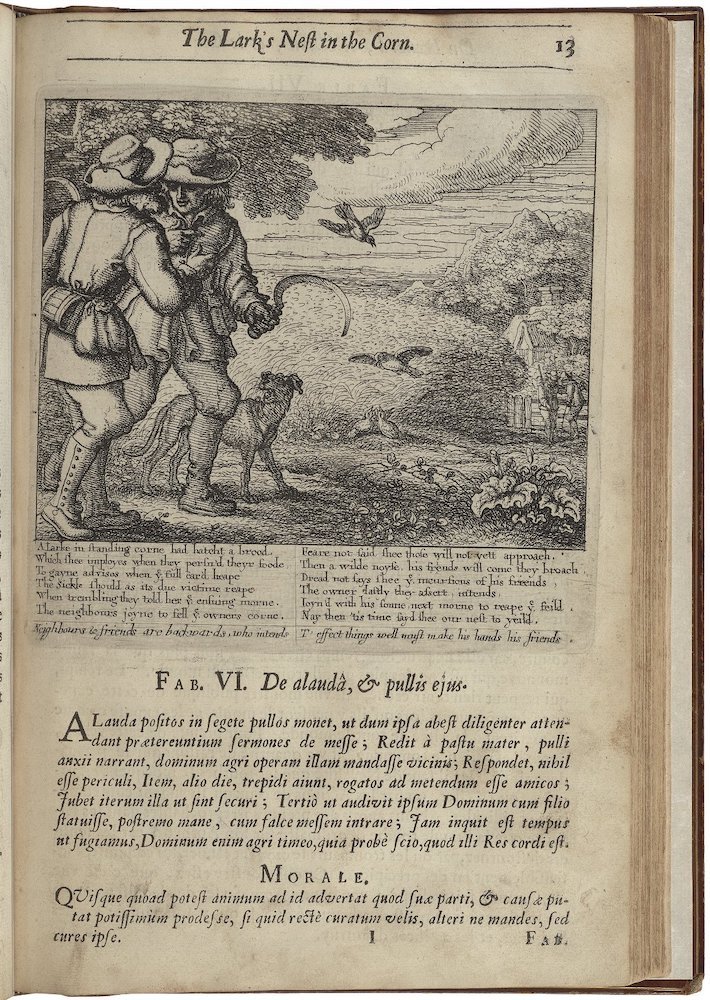Eurasian Skylark (Alauda arvensis)
Painting by Missy Dunaway. Created with acrylic ink on paper. 30x22 inches (76x56 cm)
Painting Key
Fauna: 3 Eurasian skylarks (Alauda arvensis), 2 common toads
Objects: 9 Eurasian skylark feathers, red fabric on a string
Plants mentioned by Shakespeare: Grass, honeysuckle, poppy
Shakespeare’s Lark
Occurrences in text: 27
Plays: All's Well That Ends Well, Cymbeline, Henry V, Henry VIII, King Lear, Love's Labor's Lost, Merchant of Venice, Midsummer Night's Dream, Richard II, Richard III, Romeo and Juliet, The Taming of the Shrew, Titus Andronicus, Troilus and Cressida, The Winter's Tale
Poems: “Sonnet 29,” “Venus and Adonis”
Name as it appears in the text: "lark"
It is the dawn of a new year, the ideal time to meet Shakespeare's herald of the dawn: the lark. Shakespeare mainly employs the lark as a beloved symbol for the morning. Most of the lark’s 27 appearances feature it welcoming the start of each day with a sweet song.
The skylark (Alauda arvensis) is a small, plain-looking songbird with a small crest of feathers on its head. It sings a complicated melody delivered in a remarkable "song flight," for which it hovers up to 1,000 feet above ground to project its voice over its territory.[1] Scientists speculate that the lark has such a dazzling tune because it lacks any visible distinctions to attract a mate.
Many of Shakespeare’s predecessors and contemporaries described the lark’s music, including Geoffrey Chaucer, Edmund Spenser, John Milton, William Browne, Michael Drayton, John Lyly, Ben Jonson, and Christopher Marlowe, among others.[2] Larks were well-known and abundant in Shakespeare's lifetime because of England's bountiful meadows and fields— the lark’s preferred habitat.[3]
A lark's nest is discovered in stalks of corn ripe for reaping in this illustration of Aesop's fable, "The Lark's Nest in the Corn," from 1666. Folger Shakespeare Library
Like the eagle, the lark was believed to ascend such great heights that it could fly to heaven.[4] This image is called to mind in Shakespeare's 29th sonnet:
Sonnet 29 (Line 9)
Yet in these thoughts myself almost despising,
Haply I think on thee, and then my state,
Like to the lark at break of day arising
From sullen earth, sings hymns at heaven's gate;
For thy sweet love remembered such wealth brings
That then I scorn to change my state with kings.
The lark may be best known for its song, but it offers some surprises. Shakespeare makes two lark references outside of the bird’s typical musical associations. In Henry VIII, the Earl of Surrey urges his peers not to heed a corrupt cardinal's words and to ignore his red clothing, which signifies the cardinal’s religious position and status. Surrey mocks the cardinal for flashing his red hat to his followers as though they are larks. Larks are attracted to red, so sixteenth-century hunters would tempt them close with a scarlet cloth then catch them in a net.[5]
Henry VIII (Act III, Scene 2, Line 338)
SURREY: Can you endure to hear this arrogance?
And from this fellow? If we live thus tamely,
To be thus jaded by a piece of scarlet,
Farewell, nobility. Let his Grace go forward
And dare us with his cap, like larks.
The lark was hunted using a piece of red cloth and was believed to have traded eyes with the toad.
Larks were hunted and roasted for food or kept in the home as caged pets.[6] Many caged larks were blinded due to a superstition that doing so would enhance their voice.[7] Despite having a beautiful song and nimble body, the lark was thought to have unattractive eyes.[8] According to folklore, the lark traded its eyes with the toad, giving the lark homely eyes and the toad handsome eyes.[9] Juliet mentions this strange and charming bit of folklore in the third act of Romeo and Juliet:
Romeo and Juliet (Act III, Scene 5, Line 27)
JULIET: It is the lark that sings so out of tune,
Straining harsh discords and unpleasing sharps.
Some say the lark makes sweet division.
This doth not so, for she divideth us.
Some say the lark and loathèd toad changed eyes.
O, now I would they had changed voices too,
Since arm from arm that voice doth us affray,
Hunting thee hence with hunt's-up to the day.
O, now begone. More light and light it grows.
Juliet loathes the lark’s song, as it is Romeo’s signal to depart her bedroom in the morning. Illustration by Felix Octavius Carr Darley (1884?). Folger Shakespeare Library
The lark’s song, so beautiful to others, is loathed by Juliet because it signals when she and Romeo must separate. Expressing her dismay, Juliet wishes that the lark and toad had traded their voices as well as their eyes. That way, the lark’s voice would not signal Romeo’s departure. Juliet references the lark more than any other Shakespearean character. Four references are credited to her name.
Next month, we will continue our birdwatching expedition through Shakespeare’s plays by visiting Juliet’s favorite bird, the nightingale.
Endnotes
[1] "Skylark Nesting and Breeding Habits." Royal Society for the Protection of Birds. www.rspb.org.uk/birds-and-wildlife/wildlife-guides/bird-a-z/skylark/nesting-and-breeding-habits/. Accessed 3 Jan. 2023.
[2] Phipson, Emma. Animal Lore of Shakespeare's Time. Glastonbury, The Lost Library, Kegan Paul, 1883. p. 198.
[3] Phipson, Emma. Animal Lore of Shakespeare's Time. Glastonbury, The Lost Library, Kegan Paul, 1883. p. 198.
[4] Harting, James. The Birds of Shakespeare. London, John Van Voorst, 1871. pp. 130-136.
[5] Harting, James. The Birds of Shakespeare. London, John Van Voorst, 1871. pp. 130-136.
[6] Greenoak, Francesca. All the Birds of the Air. 2nd ed., Penguin Books, 1981. p. 189.
[7] Greenoak, Francesca. All the Birds of the Air. 2nd ed., Penguin Books, 1981. p. 189.
[8] Harting, James. The Birds of Shakespeare. London, John Van Voorst, 1871. pp. 130-136.
[9] Harting, James. The Birds of Shakespeare. London, John Van Voorst, 1871. pp. 130-136.



